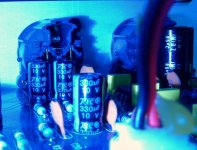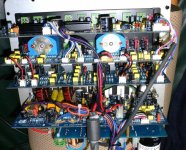The model is representational of loopback configurations I have measured response using various sound cards connected to line level circuits, recorders, and power amplifiers.
In examples, applied filter is below fundamentals, thus periods remain fixed. Phase shift applied to fundamental effectively becomes excess phase, and factors out.
I do some of my best thinking after a good hogwash.
Use of least expensive parts that produce target is anti-commercialism?
Regards,
Andrew
In examples, applied filter is below fundamentals, thus periods remain fixed. Phase shift applied to fundamental effectively becomes excess phase, and factors out.
I do some of my best thinking after a good hogwash.
Use of least expensive parts that produce target is anti-commercialism?
Regards,
Andrew
Quite the contrary.Use of least expensive parts that produce target is anti-commercialism?
Of course, you shouldn't disclose it to the public even under torture.
I agree that frequency-dependent phase inaccuracy could be bad for soundstage imaging. But I see no "smearing" of the vertical portions of the waveforms, in Andrew's post.
Also, I cannot see how using an input capacitor, even a "PPMF", would solve a problem caused by using an input capacitor. And if you are using a DC servo, then why have a blocking capacitor??
Also, it appears that your square wave is significantly distorted, maybe due to a blocking-capacitance value that is too low, or a resistance value that is too low, or a source that cannot supply enough current, for some reason. Or, maybe the DC servo's time-constant is acting too quickly, and trying to correct the temporarily-constant-DC parts of the square wave back to zero.
(Assuming your scope probe was properly compensated, the concave shape of the decay of the square wave voltage is not what would typically be caused by an RC discharge effect. So maybe it is just the servo...)
The square wave is showing that the signal decays at a very slow rate as compared to most cap coupled audio inputs despite being only 1uf. Because the signal has very slow components (20Hz square wave) there is some DC servo action being applied but the point is the slow decay of the input signal. (Servo Fc~0.3Hz) 1/(2PI*20KHz*1^-6)=8R, 1/(2PI*20Hz*1^-6)=8K. When compared to 150K or higher, this difference in capacitor Z is about 5% resulting in a much smaller % difference in phase shift between 20Hz and 20KHz signals. The rest of my point is that electros suck in the signal path for other reasons so in order to use an appropriate type of film cap, the component values may need adjusted. After all, you could use a paper and oil cap but they are physically very large for the values intended here.
The square wave is showing that the signal decays at a very slow rate as compared to most cap coupled audio inputs despite being only 1uf. Because the signal has very slow components (20Hz square wave) there is some DC servo action being applied but the point is the slow decay of the input signal. (Servo Fc~0.3Hz) 1/(2PI*20KHz*1^-6)=8R, 1/(2PI*20Hz*1^-6)=8K. When compared to 150K or higher, this difference in capacitor Z is about 5% resulting in a much smaller % difference in phase shift between 20Hz and 20KHz signals. The rest of my point is that electros suck in the signal path for other reasons so in order to use an appropriate type of film cap, the component values may need adjusted. After all, you could use a paper and oil cap but they are physically very large for the values intended here.
But big polypropylenes, for audio, even in the 50 uF to 100 uF range, are quite common and relatively inexpensive. They sell them for making speaker crossovers and such, at places like madisound and parts-express. Pricing is very reasonable, for many of them. They might measure on the order of 2.5 x 1.25 inches for 50 uF. But so what? This is supposed to be hi-fi. I certainly wouldn't compromise on that basis, for my personal system, whether built by me or purchased commercially.
"Revel states that the low frequency (-3db point) is 18Hz.If your input capacitor is 330µF your input impedance would be about 27Ω)for a -3db point of 18Hz. R=1/(2*PI*F*C), 26.79=1/(2*3.141*18*330E-6). If your input impedance is that low, what are you driving it with?
Even if your input impedance was 1000Ω (which is still low for almost any amp) you would only need an input capacitor of 8.8 µf for a -3db point of 18Hz."
Tony & RJM1 - thanks for comments , please see below pictures , it is indeed 330uf 10v and of general quality , I would say , "Rec" unknown to me ,
there are 3 input caps , 2 for balance and 1 for single end , picture shows R channel , I have modified the L channel with 2 Blackgate 330uf 16v and it does tighten up the bass .
As I only have 1 Sub out from AV processor , I would prefer more gain , 6db at least so that I can have better in hand control , both Processor & Sub had been pushed up for max. out , it is just barely sufficient .
Any easy way to do that ??
Thanks all again !
Larry
Attachments
The Revel manual states -3dB at 18Hz for acoustic output. Designing input with this corner frequency would reliably mangle phase of low frequency input.
Regards,
Andrew
The lower the corner frequency is set, the less phase shift there will be.
If the -3 dB corner frequency is set to around 0.7 Hz, by using a first-order CR high-pass with 22 uF and 10k Ohms, then the phase shift at 18 Hz would only be about 2 degrees, decreasing from there as frequency goes upward from 18 Hz and eventually going to zero degrees for all higher frequencies.
Hello,
Just read National Semiconductor (acquired by Texas Instruments) application note AN-1490.
After looking at the note and the schematic, seems they are using 22uf cap for the input blocking.
From Bates articles and comments from Doug Self and others, seems it has been shown that when using electrolytic caps, using a bi-polar, large value with a large voltage rating makes for minimal distortion. Pushing what distortion there is to very low frequency and levels.
Not sure article proves much as it never states that they tried anything like a bi-polar 220uv 50 volt cap. Just says all caps are nasty, generalizations are not often correct as correct usage makes a great deal of difference.
FWIW.
Just read National Semiconductor (acquired by Texas Instruments) application note AN-1490.
After looking at the note and the schematic, seems they are using 22uf cap for the input blocking.
From Bates articles and comments from Doug Self and others, seems it has been shown that when using electrolytic caps, using a bi-polar, large value with a large voltage rating makes for minimal distortion. Pushing what distortion there is to very low frequency and levels.
Not sure article proves much as it never states that they tried anything like a bi-polar 220uv 50 volt cap. Just says all caps are nasty, generalizations are not often correct as correct usage makes a great deal of difference.
FWIW.
- Status
- This old topic is closed. If you want to reopen this topic, contact a moderator using the "Report Post" button.
- Home
- Amplifiers
- Solid State
- Question on input dc blocking capacitors

